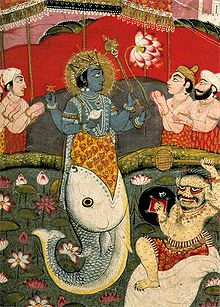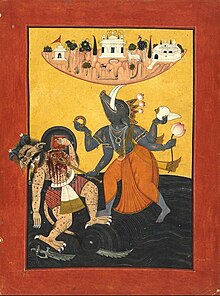Avatar

In Hinduism, Avatar or Avatara (Devanagari अवतार, IAST avatāra, Sanskrit for "descent" viz., from heaven to earth, from the verbal root tṝ "to cross over") refers to a deliberate descent of a deity from heaven to earth, and is mostly translated into English as "manifestation" of God. It corresponds more closely to the view of Docetism in Christian theology, as distinct from the idea of incarnation in mainstream Christology and its implication of God 'in the flesh'.[1][2]
The term is most often associated with Vishnu, though it has also come to be associated with other deities.[3] Varying lists of avatars of Vishnu appear in Hindu scriptures, including the ten (daśāvatāra) of the Garuda Purana and the twenty-two avatars in the Bhagavata Purana, though the latter adds that the incarnations of Vishnu are innumerable.[4] The avatars of Vishnu are a primary component of Vaishnavism.
Shiva, and Ganesha are also described as descending in the form of avatars, with the Ganesha Purana and the Mudgala Purana describing the specific avatars of Ganesha. The various manifestations of Devi, the Divine Mother principal in Hinduism, are also described as avatars or incarnations by some scholars and followers of Shaktism.[5][6] The avatars of Vishnu carry a greater theological prominence than those of other deities —which some scholars see as imitative of the Vishnu avatar lists.[1][7]
One of the earliest references to avatar, and the first to mention the doctrine of avatar, is in the Bhagavad Gita.[5] An oft-quoted passage describes the typical role of an avatar of Vishnu—to bring dharma, or righteousness, back to the social and cosmic order:[1][3]
Whenever righteousness wanes and unrighteousness increases I send myself forth.
In order to protect the good and punish the wicked,
In order to make a firm foundation for righteousness,
I come into being age after age. (4.7–8)
Avatars of Vishnu
The most widely known forms of Avatar within Hinduism are the descents of Vishnu, the preserver or sustainer aspect of God within the Hindu Trinity or Trimurti.
In the Garuda Purana


The ten most well known descents of Vishnu are collectively known as the Dasavatara (Sanskrit: ten avatars). This list is included in the Garuda Purana (1.86.10"11).[8]
The first four are said to have appeared in the Satya Yuga (the first of the four Yugas or ages in the time cycle described within Hinduism). The next three avatars appeared in the Treta Yuga, the eighth descent in the Dwapara Yuga and the ninth in the Kali Yuga. The tenth, Kalki, is predicted to appear at the end of the Kali Yuga.[9]
- Matsya, the fish, appeared in the Satya Yuga.
- Kurma, the tortoise, appeared in the Satya Yuga.
- Varaha, the boar, appeared in the Satya Yuga.
- Narasimha, the half man/half lion appeared in the Satya Yuga.
- Vamana, the dwarf, appeared in the Treta Yuga.
- Parashurama, sage with the axe, appeared in the Treta Yuga.
- Rama, the king of Ayodhya, appeared in the Treta Yuga.
- Krishna (meaning "dark coloured" or "all attractive").
- Gautama Buddha (meaning "the enlightened one") appeared in the Kali Yuga (specifically as Siddhartha Gautama).
- Kalki ("Eternity", or "time", or "The Destroyer of foulness"), who is expected to appear at the end of Kali Yuga.
In the Bhagavata Purana
Twenty-two avatars of Vishnu are listed numerically in the first book of the Bhagavata Purana as follows:[10]
- Four Kumaras [BP 1.3.6] (The Four Sons of Brahma)
- Varaha [BP 1.3.7] (The boar)
- Narada [BP 1.3.8] (The Traveling Sage)
- Nara-Narayana [BP 1.3.9] (The Twins)
- Kapila [BP 1.3.10] (The Philosopher)
- Dattatreya [BP 1.3.11] (Combined Avatar of The Trimurti)
- Yajna [BP 1.3.12] (Vishnu temporarily taking the role of Indra)
- Rishabha [BP 1.3.13] (Father of King Bharata and Bahubali)
- Prithu [BP 1.3.14] (King who made earth Beautiful and Attractive)
- Matsya [BP 1.3.15] (The Fish)
- Kurma [BP 1.3.16] (The Tortoise)
- Dhanvantari [BP 1.3.17] (Father of Ayurveda)
- Mohini [BP 1.3.17] (Beautiful/Charming Woman)
- Narasimha [BP 1.3.18] (The Man-Lion)
- Vamana [BP 1.3.19] (The Dwarf)
- Parasurama [BP 1.3.20] (The Rama with an Axe)
- Vyasa [BP 1.3.21] (Compiler of the Vedas)
- Rama [BP 1.3.22] (The King of Ayodhya)
- Balarama [BP 1.3.23] (Krishna's Elder Brother)
- Krishna [BP 1.3.23] (The Cowherd also Svayam Bhagavan)
- Buddha [BP 1.3.24] (The Enlightened)
- Kalki [BP 1.3.25] (The Destroyer)
Besides these, another four avatars are described later on in the text as follows:
- Prshnigarbha [BP 10.3.41] (Born to Prshni)
- Hayagriva [BP 2.7.11] (The Horse)
- Hamsa [BP 11.13.19] (The Swan)
- Golden avatra [BP 11.5.32] (Avatara in Kali-yuga for propagating hari-namasankirtan)
Avatars of Ganesha
The Linga Purana declares that Ganesha incarnates to destroy demons and to help the gods and pious people.[11]
In the Mudgala Purana
The Mudgala Purana describes eight avatars of Ganesha:[12]
- Vakratunda (Vakratuṇḍa) ("twisting trunk"), his mount is a lion.
- Ekadanta ("single tusk"), his mount is a mouse.
- Mahodara ("big belly"), his mount is a mouse.
- Gajavaktra (or Gajānana) ("elephant face"), his mount is a mouse.
- Lambodara ("pendulous belly") , his mount is a mouse.
- Vikata (Vikaṭa) ("unusual form", "misshapen"), his mount is a peacock.
- Vighnaraja (Vighnarāja) ("king of obstacles"), his mount is the celestial serpent Śeṣa.
- Dhumravarna (Dhūmravarṇa) ("grey color") corresponds to Śiva, his mount is a horse.
In the Ganesha Purana
Four avatars of Ganesha are listed in the Ganesha Purana:[13]
- Mohotkata, depicted with a lion.
- Mayūreśvara, depicted with a peacock.
- Dhumraketu, depicted with a horse.
- Gajanana, depicted with a rat.
Avatars of Shiva
The Linga Purana speaks of twenty-eight avatars of Shiva.[14] In the Shiva Purana, Shiva brings forth Vīrabhadra, one of his terrifying forms, in order to calm Narasimha, an avatar of Vishnu. When that fails, Shiva manifests as the human-lion-bird Sárabha. The story concludes with Narasimha becoming a devotee of Shiva after being bound by Sárabha.[15]
Avatars of Devi
Avatars are also observed in Shaktism, the sect dedicated to the worship of the Goddess (Devi), but they do not have universal acceptance in the sect. The Devi Bhagavata Purana describes the descent of Devi avatars to punish the wicked and defend the righteous—much as the Bhagavata Purana does with the avatars of Vishnu.[16] Like Vishnu, his consort Lakshmi incarnates as Sita and Radha - the consorts of Rama and Krishna avatars.[17] Nilakantha, an 18th century commentator on the Devi Bhagavata Purana - which includes the Devi Gita - says that various avatars of the Goddess includes Shakambhari and even the masculine Krishna and Rama - generally thought to be Vishnu's avatars.[18] Mahalakshmi (Lakshmi) and Mahasaraswati (Saraswati) are also Goddesses worshiped as Devi avatars.[19]
Other kinds of avatars within Vaishnavism
Although it is usual to speak of Vishnu as the source of the avataras, within the Vaishnavism branch of Hinduism Vishnu is only one divine being that manifests in form. In that tradition Narayana, Vasudeva and Krishna are also seen as names denoting divine aspects which take avataric form.[1]
See also
| Part of a series on |
| Hinduism |
|---|
 |
References
- ^ a b c d Matchett, Freda (2001). Krishna, Lord or Avatara?: the relationship between Krishna and Vishnu. 9780700712816. p. 4.
- ^ Edward Geoffrey Parrinder, Avatar and incarnation (1970, 1997), chapter "Docetism, in Buddhism and Christology", pp. 240ff.; Mercy Amba Oduyoye, H. M. Vroom, One gospel - many cultures: case studies and reflections on cross-cultural theology, Rodopi, 2003, ISBN 9789042008977, p. 111.
- ^ a b Kinsley, David (2005). Lindsay Jones (ed.). Gale's Encyclopedia of Religion. Vol. 2 (Second Edition ed.). Thomson Gale. pp. 707–708. ISBN 0-02-865735-7.
{{cite book}}:|edition=has extra text (help) - ^ Bryant, Edwin Francis (2007). Krishna: A Sourcebook. Oxford University Press US. p. 18. ISBN 9780195148916.
- ^ a b Sheth, Noel (Jan. 2002). "Hindu Avatāra and Christian Incarnation: A Comparison". Philosophy East and West. 52 (1 (Jan. 2002)). University of Hawai'i Press: 98–125.
{{cite journal}}: Check date values in:|date=(help) - ^ Hawley, John Stratton (2006). The life of Hinduism. University of California Press. p. 174. ISBN 9780520249141.
{{cite book}}: Unknown parameter|coauthors=ignored (|author=suggested) (help) - ^ * For the four Ganesha incarnations in Ganesha Purana are given in John A. Grimes. Ganapati: Song of the Self. pp. 100-105. (State University of New York Press: Albany, 1995) ISBN 0-7914-2440-5
- For the eight incarnations in Mudgala Purana, see John A. Grimes pp. 105-110
- ^ Garuda Purana (1.86.10–11)
- ^ Matchett, p. 86.
- ^ Bhag-P 1.3 Canto 1, Chapter 3
- ^ Grimes, John A. (1995). Gaṇapati: song of the self. SUNY Press. p. 105. ISBN 9780791424391.
- ^ Phyllis Granoff, "Gaṇeśa as Metaphor," in Robert L. Brown (ed.) Ganesh: Studies of an Asian God, pp. 94-5, note 2. ISBN 0-7914-0657-1
- ^ Grimes, pp. 100-105.
- ^ Winternitz, Moriz (1981). A History of Indian Literature, Volume 1. Motilal Banarsidass. pp. 543–544. ISBN 9788120802643.
{{cite book}}: Unknown parameter|coauthors=ignored (|author=suggested) (help) - ^ Soifer, Deborah A. (1991). The myths of Narasiṁha and Vāmana: two avatars in cosmological perspective. SUNY Press. pp. 91–92. ISBN 9780791407998.
- ^ Brown, Cheever Mackenzie (1990). The triumph of the goddess: the canonical models and theological visions of the Devī-Bhāgavata Purāṇa. SUNY Press. p. 32. ISBN 9780791403631.
- ^ Hindu Avatāra and Christian Incarnation: A Comparison, Noel Sheth Philosophy East and West, Vol. 52, No. 1 (Jan., 2002), pp. 98, 117.
- ^ The Devī Gītā: the song of the Goddess. p. 272. verses 9.22cd-23ab
- ^ Brown, p. 270.

